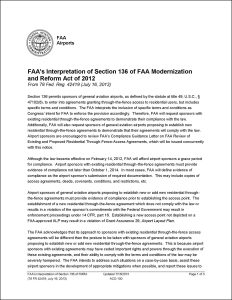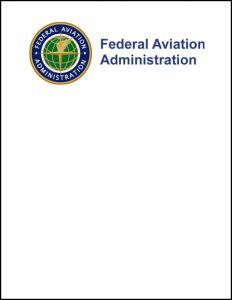To narrow the library of airside resources, use the filter boxes or airport map below or search box above.
Click an item below to expand.
Resources Matching Your Search
2021
The purpose of this compliance guidance letter is to provide guidance to FAA airports personnel responsible for reviewing existing and proposed residential through-the-fence agreements incorporating Section 185 of the FAA Reauthorization Act of 2018 (P.L. 115-254) signed on October 5, 2018. This compliance guidance letter replaces and supersedes the guidance issued on September 16, 2013 (Compliance Guidance Letter 2013-01—FAA Review of Existing and Proposed Residential Through the-Fence Access Agreements).
2013
Section 136 of P.L. 112-95 requires residential through-the-fence (RTTF) users to pay access charges that the airport sponsor determines to be comparable to fees charged to tenants and operators on an airport making similar use of the airport, as a minimum.
2013
This final policy applies to commercial service airports with existing residential through-the-fence access.
2013
On February 14, 2012, the FAA Modernization and Reform Act of 2012 was signed into law (P.L. 112-95). Section 136 of this law permits general aviation airports, as defined by the statute, to enter into residential through-the-fence agreements with property owners or associations representing property owners for non-commercial use. RTTF agreements must comply with specific terms and conditions contained in the law. This document outlines the specific terms and conditions as Congress' intent for the FAA to enforce the provision accordingly. Therefore, the FAA will request sponsors with existing residential through-the-fence agreements to demonstrate their compliance with the law. Additionally, the FAA will request the sponsors of general aviation airports proposing to establish new residential through-the-fence agreements to demonstrate that their agreements will comply with the law.
FAA Recommendations for Airport Sponsors Considering Residential Through-the-Fence Access Agreements
2012
The FAA Modernization and Reform Act of 2012, Section 136 (Section 136) permits sponsors of publicly owned general aviation airports to establish residential through-the-fence access (RTTF) agreements that comply with specific terms and conditions. Airport sponsors considering such agreements are strongly encouraged to work with the FAA to ensure their proposals: 1) are consistent with the current and future plans for the airport, 2) comply with the terms and conditions of Section 136, and 3) do not impede the sponsor's ability to comply with its federal grant assurances.
2013
Residential through-the-fence (RTTF) agreements allow people who own residential property with aircraft storage facilities near an airport to access the airport from off-airport property. These properties are sometimes known as hangar homes. On February 14, 2012, the FAA Modernization and Reform Act of 2012 was signed into law (P.L. 112-95). Section 136 of this law permits general aviation airports, as defined by the statute, to enter into residential through-the-fence agreements with property owners or associations representing property owners for non-commercial use. RTTF agreements must comply with the specific terms and conditions contained in the law. Section 185 of the FAA Reauthorization Act of 2018 (P.L. 115-254) was signed into law October 5, 2018. Section 185 permits the exemption of certain RTTF agreements that are non-commercial, considered perpetual and cannot be readily changed. However, the law also provides that if the agreement can be modified, then Section 185 does not apply. This document provides a summary between the sponsor and residential through-the-fence user(s). This document provides a sample access agreement and a review sheet to use to review existing agreements. The FAA also has a review sheet for general aviation sponsors' proposed new access.




